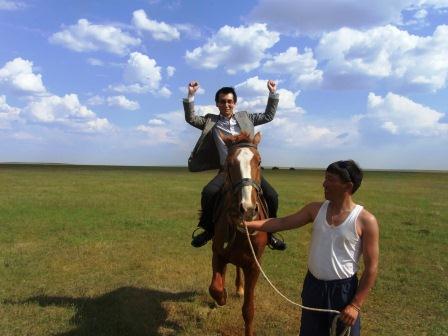
Takehiko Inoue
Specially Appointed Assistant Professor
Modern and Contemporary History of Central Eurasia, Russian Buddhist Cultural Studies
Contact: inouetkhk@slav.hokudai.ac.jp
Takehiko Inoue

Education:
2014 Ph.D., Hokkaido University
2005 M.A., Hokkaido University
2003 B.A., Hokkaido University
Field of Study:
My research theme focuses on the history of Tibetan Buddhist followers, the Kalmyks and the Buriats, in the Russian Empire. My dissertation addressed two Kalmyk Buddhist communities in the late Imperial period. I engaged in topics on the re-ignited pilgrimage to Tibet and the Kalmyk imagination on the Russian emperors as the reincarnation of Boddhisattva. In my dissertation, I used archival materials of Saint Petersburg, Moscow, Elista, Astrakhan, Rostov-on-Don, Stavropol, and other Russian cities. My recent research interests concern the human interaction between Tibetan Buddhist subjects in the Russian Empire and other Buddhist followers in Asia in the late nineteenth and twentieth centuries. I am also interested in the transformation of the Kalmyk lifestyle, especially, the relations between sedentarization and fishing-pastoralism.
Recent Publications (Selected):
Edited Books:(with Yumiko Ishihama, Ryosuke Kobayashi, Makoto Tachibana) The Resurgence of“Buddhist Government”: Tibetan-Mongolian Relations in the Modern World. Osaka: Union Press, 2019.
Journal Articles:
(with Shohei Saito) “Munich Days: From an Interview with a Russian ‘Displaced Pearson’,” Japan Border Review 12, pp. 55-76, 2022 (in Japanese).
“From Nomadic Pastoralism to Semi-Settled Fishing-Pastoralism: Transformation of Kalmyk Society from the Late Eighteenth to the Mid-Nineteenth Centuries,” JCAS Review 20, no. 1, pp. 37-55, 2020 (in Japanese).
(With Yumiko Ishihama) “The Historical Significance of the Three Tibetan Letters Attributed to Agvan Dorzhiev in Saint Petersburg Branch of the Archive of the Russian Academy of Sciences,” Inner Asian Studies (Japanese Society of Inner Asian Studies) 33, pp. 99-117, 2018 (in Japanese).
“Transformed Nomadic Leadership in the Kalmyk Steppe from the Early Seventeenth to the Early Twentieth Centuries,” Russian History (Japanese Society of Russian History) 100, pp. 145-165, 2017 (in Japanese).
“Dambo Ul’ianov’s Prophecies of Buddha and His Interpretation of Russian Monarchs as Buddhist Emperors,” Slavic Studies (Slavic-Eurasian Research Center) 62, pp. 45-77, 2016 (in Japanese).
“О разработке ‘Положения об оспопрививании в калмыцких улусах’ (1839 г.): по материалам переписки И.С. Тимирязева и П.Д. Киселёва,” Астраханские краеведческие чтения 5, С. 192-196, 2013
“The Smallpox Vaccination of Kalmyk Buddhist Monks in the Nineteenth Century: At the Junction of Medical History and History of the Religious Policies in the Russian Empire,” Russian History (Japanese Society of Russian History) 86, pp. 67-84, 2010 (in Japanese).
Book Chapters:
“A Study of three Tibetan letters attributed to Dorzhiev held by the St. Petersburg Branch of the Archive of the Russian Academy of Sciences” (co-authored Ishihama Yumiko), pp. 135-165; “Buddhist Devotion to the Russian Tsar : The Bicultural Environment of the Don Kalmyk Sangha and Russian Orthodox Church in the 1830s,” pp. 189-201, in Ishihama Yumiko and Alex McKay, eds., The Early 20th Century Resurgence of the Tibetan Buddhist World: Studies in Central Asian Buddhism (Amsterdam: Amsterdam University Press, 2022).
“Why Do Pastoralists in Russia Love Eating Fish? Sedentarization and Survival Strategy,” In: Shinjilt and Tetsuro Chida, eds., Exploring Pastoralism in the Humanities. Nagoya: Nagoya University of Foreign Studies Press, 2021, pp. 48-65 (in Japanese).
“The Evolution of a Buddhist Culture through Russian Media: Kalmyks, Orientalists and Pilgrimages in the Nineteenth and Early Twentieth Centuries,” In: Yukiko Tatsumi and Taro Tsurumi, eds., Publishing in Tsarist Russia: A History of Print Media from Enlightenment to Revolution. London: Bloomsbury Academic, 2020, pp. 123-140.
“Dreams about Building New Buddhist Sacred Places in Contemporary Kalmykia: The Relations between Buddhist Revival and Ethnic Cultural Movement,” In: Yoshio Sugimoto and Mizuho Matsuo, eds., Politics of Sacred Places: Comparative Studies on Eurasian Regional Powers. Tokyo: Fukyosha, 2019, pp. 187-212 (in Japanese).
“How the Kalmyks Turned to Sedentism,” In: Yang Haiying, ed., Changing Nomadic Civilization and Socialism in Central Asia. Nagoya: Graduate School of Humanities, Nagoya University, 2014, pp. 11-37 (in Japanese).
“Moravian Church in Sarepta: Communication between the Kalmyks and Missionaries,” In: Tetsuo Mochizuki and Shiho Maeda, eds., The Volga as Cultural Sphere. Sapporo: Slavic Research Center, Hokkaido University, 2012, pp. 25-34 (in Japanese).
“Transition between Medicine and Orientalism: Medical Treatments of the Kalmyk Buddhist Monks in the Nineteenth Century Russian Empire,” In: Evgeny Steiner, ed., Orientalism / Occidentalism: Languages of Culture vs. Languages of Description. Moscow: Sovpadenie, 2012, pp. 165-177.
Academia:
https://jsps.academia.edu/TakehikoInoue
Invited Lectures:
“The Kalmyk and Buriat Travelers in the Qing Empire in the Late Nineteenth and Early Twentieth Centuries,” International Symposium “Mobilities in the Qing Empire Revisited: Case of Mongolia,” Center for Northeast Asian Studies, Tohoku University. Sendai, Japan (21 July 2019).
“After 1877: Revival of the Kalmyk Pilgrimage,” Symposium “Trade, Pilgrimage, Asylum: Cross-Border Movements in Central Eurasia in the Seventeenth and Early Twentieth Centuries” (in Japanese). Waseda University, Tokyo, Japan (12 March 2016).
“Khorgos and Kyakhta as Pilgrimage Routes to Tibet,” International Workshop “Research Front on the History of the Dzungars” (in Japanese). Kyoto University, Kyoto, Japan (23 January 2016).
“Exclusion or Inclusion? The Kalmyk Medicine in the Russian Empire,” The 34th International Conference of the Korean Association for Mongolian Studies. Seoul, South Korea (28 March 2014).
Courses Taught:
Grants and Fellowships:
- Buddhist Monks in Social Service in the Russian Empire (JSPS: Grant-in-Aid for Young Scientists, 2020-2022)
- Relationship between the Buddhist Monks in the Russian Empire and the National Elites in South and Southeast Asia (JSPS: Grant-in-Aid for Young Scientists B, 2016-2021)
- Application of Russian Qing Studies to the Domestic Policies toward the Buddhist Subjects (JSPS: Grant-in-Aid for JSPS Fellows, 2016-18)
- Comparative studies on the Images of the Buddhist Emperors in the Kalmyk and Buriat Societies (Grant of The Konosuke Matsushita Memorial Foundation, 2014-2015)
- Role of the Buddhist Monks in the Kalmyk Society (JSPS: Grant-in-Aid for JSPS Fellows, 2013)
- Influence of the Kalmyk Buddhist Monks in the Integration Process of the Russian Empire (Young Research Fellowship, Japan Russia Youth Exchange Center, 2011)